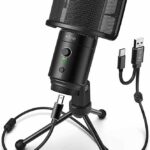To connect a microphone to a desktop computer, you will need the appropriate audio input jack for your microphone. Depending on the type of microphone and sound card being used, this may be either a 1/8″ stereo mini plug or an XLR connector. If your sound card does not have these inputs then you can purchase an adapter that will convert the microphone’s output to fit into one of your other audio jacks.
Once connected, open up the Sound Settings in Windows Control Panel or System Preferences in Mac OS X and make sure that the correct input device is selected from within there. You may also need to adjust some settings such as volume level and gain depending on what type of mic you are using. Finally, ensure that any recording software you’re using is recognizing the mic correctly by checking its settings menu.
Table of Contents
How Do I Connect a Microphone to a Desktop Computer Step By Step Guide
How to connect microphone to pc windows 10 (Desktop)
Connecting a microphone to a desktop computer is simple and straightforward. First, you will need to determine if your desktop has an audio input port. If it does not have one, then you’ll need to purchase and install an external sound card.
Once the sound card is installed, connect your microphone directly into the appropriate audio input port on the sound card. To ensure that the microphone is working properly with your computer, check your system preferences or device manager for settings related to input devices such as microphones or headsets. With these steps in mind, connecting a microphone to a desktop should be quick and easy!
How to Connect Microphone to Pc Windows 11
How to Connect Microphone to Pc Windows 10
Connecting a microphone to a Windows 10 PC is a straightforward process. Here are the general steps to do this:
Step 1: Check Your Microphone
Make sure your microphone is compatible with your PC and is in good working condition.
Step 2: Connect the Microphone
USB Microphones:
If you have a USB microphone, simply plug it into an available USB port on your computer.
Analog Microphones:
If you have a microphone with a 3.5mm audio jack, you can connect it to the microphone port on your PC. This port is often colored pink.
Bluetooth Microphones:
For Bluetooth microphones, make sure Bluetooth is enabled on your PC, and follow the manufacturer’s instructions to pair the microphone.
Step 3: Check Microphone Settings
- Right-click on the speaker icon in the system tray (bottom-right corner of your screen).
- Select “Open Sound settings” or “Recording devices,” depending on your Windows version.
Step 4: Set Up Microphone
- In the Sound settings or Recording devices window, you should see your microphone listed. It may be identified by name or as “Microphone” with a type designation.
- If it’s not set as the default device, right-click on your microphone and select “Set as Default Device.”
- You can also adjust the microphone volume by moving the slider up or down.
Step 5: Test Your Microphone
- Open the Sound settings or Recording devices window.
- Speak into your microphone, and you should see the green bars next to your microphone in the “Test your microphone” section. This indicates that your microphone is working.
Additional Troubleshooting Tips:
- Drivers: Ensure that your microphone drivers are up to date. You can often find these on the manufacturer’s website.
- Privacy Settings: In Windows 10, go to Settings > Privacy > Microphone, and make sure that the “Allow apps to access your microphone” toggle is turned on.
- Restart Your PC: Sometimes, a simple restart can resolve microphone connection issues.
Following these steps should help you successfully connect and set up a microphone on your Windows 10 PC. If you encounter any issues, refer to the microphone’s user manual or the manufacturer’s support resources for specific troubleshooting steps.
How do I get my microphone to work on my desktop?
Getting your microphone to work on your desktop involves several steps. Here’s a general guide to help you troubleshoot and fix common microphone issues:
Check the physical connection:
- Ensure that your microphone is properly connected to the correct port on your desktop. If you’re using a USB microphone, try a different USB port.
- If your microphone has a mute button or switch, make sure it is not muted.
Verify the microphone hardware:
Test your microphone on another device, such as a laptop or a friend’s computer, to ensure that the issue is not with the microphone itself.
Check system settings:
On Windows:
- Right-click on the speaker icon in the system tray and select “Open Sound settings.”
- Under the “Input” section, make sure your microphone is selected as the default device.
- Click on the “Device properties” link to check additional settings and ensure that the microphone is enabled.
- Test your microphone using the “Test your microphone” feature in the settings.
On macOS:
- Open “System Preferences” and go to “Sound.”
- Click on the “Input” tab and select your microphone.
- Adjust the input volume slider and test your microphone.
On Linux:
Use your desktop environment’s audio settings or a dedicated audio control application to select and configure your microphone.
Update audio drivers:
Make sure your audio drivers are up-to-date. You can usually find the latest drivers on the manufacturer’s website or through Windows/Mac update services.
Check privacy settings:
On Windows, check the privacy settings for microphone access. Go to “Settings” > “Privacy” > “Microphone” and ensure that microphone access is allowed for the apps you’re using.
Use the troubleshooter:
On Windows, you can use the built-in audio troubleshooter. Go to “Settings” > “Update & Security” > “Troubleshoot” > “Additional troubleshooters” > “Playing Audio” and run the troubleshooter.
Third-party software conflicts:
Some third-party applications may interfere with your microphone. Try closing unnecessary background applications and test your microphone again.
Check for software conflicts:
Certain software, like antivirus programs, may block microphone access. Temporarily disable such software and check if the microphone works.
Operating System Updates:
Ensure that your operating system is updated to the latest version. Sometimes, system updates can address compatibility issues and improve overall performance.
Contact support:
If none of the above steps resolve the issue, consider contacting the manufacturer’s support or seeking help from online forums for more specific troubleshooting assistance.
Remember that the steps can vary slightly depending on your operating system and specific microphone model. If you provide more details about your desktop and microphone, I can offer more targeted assistance.
How to Connect Aux Mic to Pc
Connecting an Aux microphone to a PC is easy and requires only a few simple steps. First, plug your aux mic into the corresponding input port of your computer. Depending on the type of microphone you have, this may require either a 3.5mm or USB cable connection.
Next, open up the sound settings menu on your PC and select the appropriate input for your mic from the drop-down list. Finally, make sure that any audio software programs you’re using recognize and are set to use your new Aux microphone as their primary sound source before beginning recording!
How to Connect a Microphone to a Computer
Connecting a microphone to your computer is easy and only requires a few steps. First, you will need an audio interface or sound card that has at least one input for the microphone. Once connected, open up your sound settings on the computer to ensure that the microphone is recognized.
You may also have to adjust some settings in order to optimize sound quality. Finally, make sure the volume levels are set correctly and begin recording!
How to Connect a Microphone to a Speaker
Connecting a microphone to a speaker is an easy process that requires some basic audio equipment. To begin, you will need an audio cable with the correct connectors on each end (for example, XLR-to-RCA or 1/8″ TRS to RCA). You will also need either an amplifier or mixer and the appropriate power cables for both your microphone and speaker.
After connecting the cables between all of your components, you can then adjust volume levels using the controls on the amplifier or mixer. With everything properly connected and configured, you should now have sound coming through your speakers when speaking into your microphone!
How to Connect Mic to Pc Windows 7
Connecting a microphone to your PC is relatively easy. First, make sure the microphone you own is compatible with Windows 7 and plug it into an available USB port or audio jack on your computer. After that, open the Control Panel and click on “Sound,” then select the Recording tab and look for the newly connected device in order to set it as default.
Finally, test out your new setup by speaking into the mic and seeing if sound can be heard through speakers or headphones connected to your computer.

Credit: mynewmicrophone.com
How Do I Connect an External Microphone to My Computer?
Connecting an external microphone to your computer is a relatively simple process and can be done in just a few steps. First, you will need to check the type of audio input port on your computer. Depending on the specific model of your computer, it could have either a USB or 3.5mm jack port for audio inputs.
Once you have determined which type of port you have available, find an appropriate microphone that matches this type of connection (USB or 3.5mm). With the correct cable connected between the microphone and your computer’s input port, all that is left is to configure sound settings on your PC so that it recognizes incoming signals from the new mic device.
To do this open up control panel/sound settings and select “recording devices” where you should see newly connected device listed as an option; make sure its properties are set as “default device” before recording anything with it!
What Do You Plug a Microphone Into?
When it comes to plugging in a microphone, you need to first consider what type of microphone you have. If you have an XLR-type mic, then you will need an audio interface or preamp to convert the signal into something that your computer or other recording device can recognize.
USB mics are much easier because they don’t require any additional hardware; simply plug them directly into one of your computer’s USB ports and start recording!
Alternatively, some microphones may require a specialized cable adapter depending on the output port of your chosen device. Regardless of what type of microphone you’re using, always double check which connectors are compatible with each other before making any connections.
Does My Desktop Have a Built in Microphone?
The answer to this question depends on the type of desktop you have. Most modern desktops come equipped with a built-in microphone, as many people use their computers for voice calls or video conferencing. However, if your desktop is an older model or a basic model, it may not have one.
To check if your computer has a built-in microphone, look in your sound settings and check for any devices listed under ‘Recording’ – you should see something like ‘Microphone’. If there’s nothing there then chances are that your desktop does not have a built-in microphone.
When Setting Up a Desktop Pc to Which Port Will You Connect the Microphone?
When setting up a desktop PC, the microphone should be connected to the audio input port. This is usually located on the back of the computer, but may also be located on the front or side panel depending on your specific model. The audio input port looks like a headphone jack and can either have an orange or pink coloration.
After connecting the microphone to this port, make sure that it has been set as default device in your sound settings for optimal performance.
Does my computer have a microphone input?
To check if your computer has a microphone input, you can follow these general steps:
- Look for a Microphone Jack:
- Check the front and back panels of your computer for a small round port (usually pink) labeled “Mic,” “Microphone,” or with a microphone icon.
- Check your Computer’s Manual:
- Consult your computer’s manual or documentation that came with it. This information is often available in the technical specifications section.
- Access Sound Settings:
- On Windows, you can right-click on the speaker icon in the system tray, select “Open Sound settings,” and look for information about input devices.
- On macOS, go to “System Preferences,” then “Sound,” and check the “Input” tab.
- Device Manager (Windows) or System Information (Mac):
- On Windows, you can open the Device Manager and look under “Audio inputs and outputs” for information about your microphone.
- On macOS, you can use the System Information app to check for audio devices.
- Online Specifications:
- Visit the official website of your computer’s manufacturer and look for specifications related to audio inputs.
If you’re still unsure or need more assistance, feel free to provide more details about your computer’s make and model, and I can try to offer more specific guidance.
FAQ of How Do I Connect a Microphone to a Desktop Computer
Here’s a frequently asked questions (FAQ) guide on how to connect a microphone to a desktop computer:
Q1: How do I physically connect the microphone to my desktop computer?
A: Most microphones use a 3.5mm audio jack or a USB connection. For a 3.5mm jack, locate the microphone input port on your computer (usually pink) and insert the microphone plug. If you have a USB microphone, simply plug it into an available USB port.
Q2: How can I check if my computer recognizes the microphone?
A: After connecting the microphone, right-click on the speaker icon in the taskbar, select “Open Sound settings” (on Windows) or go to System Preferences > Sound (on macOS). In the settings, you should see the connected microphone listed under input devices. Make sure it’s selected as the default input device.
Q3: My microphone isn’t working. What should I do?
A: First, check the physical connections. If it’s a USB microphone, try a different USB port. If it’s a 3.5mm jack, make sure it’s plugged into the correct port. Additionally, check the microphone’s mute switch (if it has one). In your computer settings, ensure the microphone is not muted, and the volume is turned up.
Q4: Can I use a microphone without a dedicated input port on my computer?
A: Yes, if your computer doesn’t have a dedicated microphone input, you can use a USB microphone, which doesn’t require a specific input port. USB microphones are plug-and-play devices and are widely compatible.
Q5: How do I test my microphone to ensure it’s working properly?
A: You can use the built-in tools on your computer to test the microphone. On Windows, you can use the “Voice Recorder” app, and on macOS, you can use the “Sound” preferences. Alternatively, you can use online platforms or applications that allow you to test your microphone by recording and playing back audio.
Q6: Can I use an external audio interface with my microphone for better audio quality?
A: Yes, if you’re looking for higher audio quality, you can use an external audio interface. Connect the microphone to the interface, and then connect the interface to your computer via USB or another appropriate connection. This is common for professional audio setups.
Conclusion
In conclusion, connecting a microphone to a desktop computer is not as difficult as it may seem. By following the steps outlined in this blog post, you can easily and quickly set up your microphone with your desktop computer for optimal sound quality. Additionally, if you experience any issues or need further assistance during the process, consulting an expert or researching online can help provide more detailed information.

Williams Kane is a blogger and writer. He’s passionate about writing and connecting with the community, especially when it comes to sharing his ideas through writing.
I am a versatile author with a passion for exploring a wide range of topics on our multi-niche website. With a background in research and a love for writing, I bring a unique blend of expertise to our platform.
My journey began in the world of science, where I earned a degree in biology and developed a deep fascination for the natural world. This background enables me to delve into topics related to ecology, environmental conservation, and the wonders of the animal kingdom.
However, my curiosity knows no bounds, and I have ventured into various other niches as well. From technology trends and digital innovations to health and wellness tips, I strive to provide well-researched and engaging content that informs and entertains our diverse audience.
Furthermore, my dedication to staying current with the latest developments in each niche ensures that our readers receive up-to-date and reliable information. Whether it’s deciphering complex scientific concepts or simplifying tech jargon, I take pride in making complex subjects accessible to all.
Join me on our multi-niche journey, where we explore the depths of knowledge and share insights on a multitude of topics to inspire, educate, and entertain.






